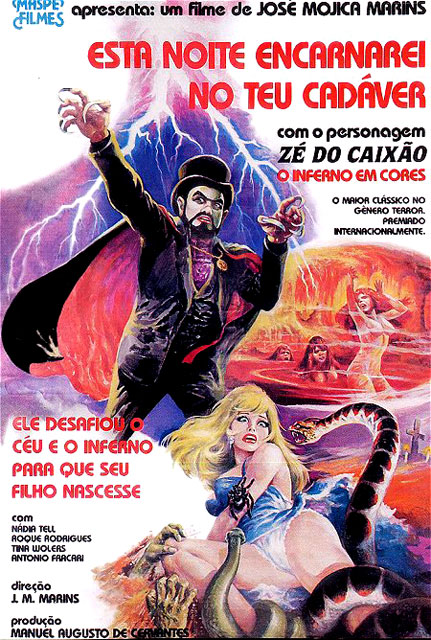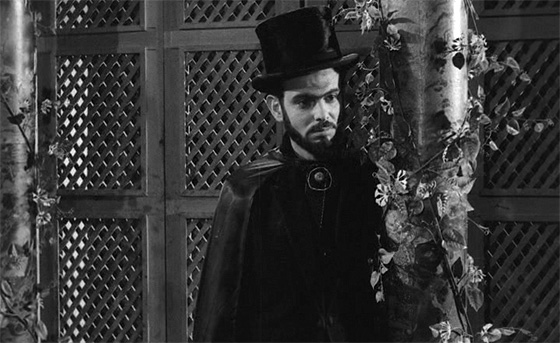
Zé do Caixão, better known to English-speaking horror fans as Coffin Joe, is the creation of director José Mojica Marins, who began playing the character in At Midnight I’ll Take Your Soul (1963), growing out his fingernails until they resembled twisted claws, wearing a top hat and black cape, and drawing innocent young women to his estate for sadistic experiments. The film was a tremendous hit in its native Brazil, a country with no real film industry to call its own (it’s often cited as Brazil’s first horror film); no doubt its success had something to do with the fact that many states in Brazil banned the film outright. Marins went deep into debt to complete the film, but, emboldened by its reception, began work on a sequel to bear a title even more breathless than its predecessor’s: This Night I’ll Possess Your Corpse (1966). Though still a low-budget endeavor, the sequel was more cinematically ambitious, and, perhaps unsurprisingly, the filming was even more tumultuous. When an actress was asked to deliver a speech with a snake wrapped around her neck, it almost choked her to death until the crew dove into the snake pit to save her. The nude actors inhabiting the set during the hallucinatory Hell sequence were treated to electrical shocks from the wires running through the floor. An unpleasant array of tarantulas were assembled for one notorious scene, and a handful of them escaped to terrorize the neighborhood. Cameraman Antonio Franchencko died during filming – of reasons unrelated to Marins’ methods, one presumes, but surely the tragedy would have only added to the film’s reputation as an unholy production. The Brazilian censors were not pleased with the blasphemous result, but the film’s release insured the immortality of Zé do Caixão. Coffin Joe haunted the pages of his own comic book, and put in cameos in Marins’ other films. He regularly dresses as the character in his daily life, as he did during an appearance at the 2001 Sundance Film Festival, introducing a midnight screening of At Midnight I’ll Take Your Soul with a sinister incantation, delivered in Portuguese.
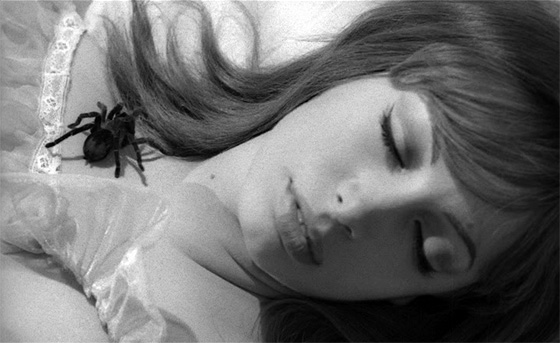
One of the many tarantulas exploring the bodies of Coffin Joe's sleeping victims.
This Night I’ll Possess Your Corpse is both shocking and charming, sometimes simultaneously. Part of this is due to the film’s age; the print used for Fantoma’s 2001 DVD release looks like it’s been rescued after playing for a few decades straight at a São Paulo moviehouse, and the soundtrack crackles like an early Universal horror film. When Marins appears on the day-lit streets in his mortician’s garb to terrorize a throng of peasants, he looks like some occult superhero: the South American Doctor Strange. When one side of his unibrow lifts as he delivers another booming threat, the effect is more comical than menacing. And the film can’t shake the influences of decades-older B-movies, from Coffin Joe’s inexplicable mad scientist’s laboratory to his defeat at the hands of a lynch mob that chases him into a swamp. On the other hand, it’s plainly evident that Marins is willing to go much further than his genre contemporaries in North America. The viewer is instantly aware that those are real tarantulas crawling all over the semi-clothed bodies of his actresses (in a sadistic bit of lasciviousness, Marins shoots the spiders crawling over the victims’ panty-clad bottoms and up through their nighties via the cleavage). A couple scenes later and the damsels are in distress in a snake pit to rival Raiders of the Lost Ark. It’s also inarguably startling to see a mid-60’s black-and-white horror film with some blunt nudity and gore, even if those moments are fleeting. For no good reason, Coffin Joe pours acid on the face of one beautiful woman, right after his hunchbacked assistant returns to the lab with her body, having accidentally snapped her neck during an off-camera rape. It’s easy to be reminded that this is not a Hollywood horror film, but a low-budget venture with non-professional actors shot in an abandoned synagogue in São Paulo.
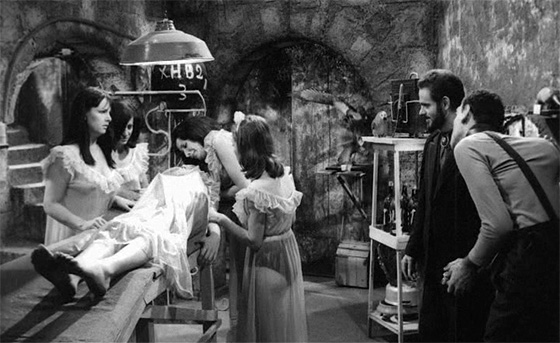
Zé do Caixão (José Mojica Marins) tortures his captive women with the help of his hunchbacked assistant.
There was a good reason Marins chose non-professionals. Real actors would complain – rightly – about being subjected to his working conditions. He tried to weed out the cowards during the casting sessions; as Marins biographer André Barcinski writes in the DVD’s liner notes, “candidates for roles in his films were told to lick snakes, handle spiders and even eat cockroaches.” Therefore to take part in a Coffin Joe movie was akin to volunteering for an episode of Fear Factor. A cast of locals were assembled for Marins’ vision of Hell, a dream sequence which arrives two-thirds of the way through the film. Hell is a wintry cavern in which the damned are unclothed and sealed into the ice and rock (heads, limbs, and buttocks extend from the walls, ceiling, and floor), to be poked and prodded by musclemen with pitchforks. Strikingly, this twelve-minute scene is shot in garish full-color, rich with greens, blues, reds, and violets. Marins stumbles through the landscape screaming in terror, finally confronting the Devil (also played by Marins, never more satyr-like), who lounges like Nero with nude, painted women feeding him grapes. This outré vision of the Underworld (with popcorn playing the role of snowfall) remains one of cinema’s most memorable, to take its own place beside Dante’s Inferno (1935) and Jigoku (1960), even with its limited budget and carnival funhouse atmosphere.
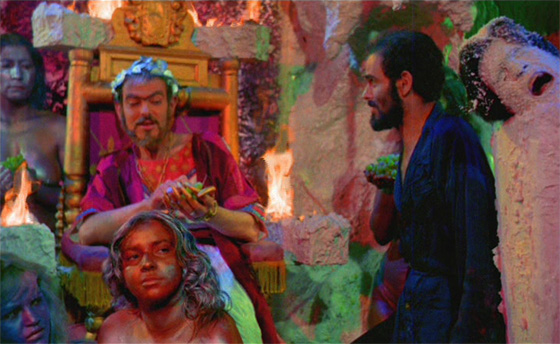
The Devil mocks Coffin Joe's atheism during the full-color Hell sequence.
The vivid representation of the afterlife that awaits Coffin Joe plays into the film’s curious thematic conflict, of a Nietzschean atheism vs. a very South American Catholicism. Zé wants to find the ideal woman to bear his child, whom he intends to raise as Nietzsche’s Übermensch. Therefore the experiments on his female captives are intended to find the one among them who is without fear or superstition. His hatred toward religion is only matched by his idealization of children, presumably because of their potential toward being amoral Supermen; when he learns that one of the women he killed was with child, he’s plunged into terror and self-loathing, prompting the Hell nightmare. During the final confrontation with the mob, Zé – drowning in a bog – seems to finally embrace his Creator, but this was merely a dialogue change imposed by the censors. It is crystal clear that Zé do Caixão embodies unrestrained power and egomania. His village lives in fear of him, and though they plot to see him arrested for his crimes, they shrink in his presence. Still, This Night I’ll Possess Your Corpse happily plays into the religious beliefs of its audience – why else would Marins spend so much money and effort on a sequence representing Hell, or focus so much of the film’s final half on Zé’s growing remorse? And there is something ultimately satisfying in seeing the overconfident villain get his comeuppance, even if it’s not quite as horrific as that featured in the climax of At Midnight I’ll Take Your Soul, which saw Coffin Joe seemingly die of fright, eyes bulging out of his skull. Two on-screen deaths can’t keep a good villain down. He’d return in the trilogy’s long-promised, long-delayed conclusion, The Embodiment of Evil, in 2008.
